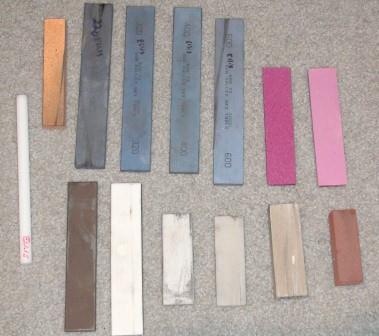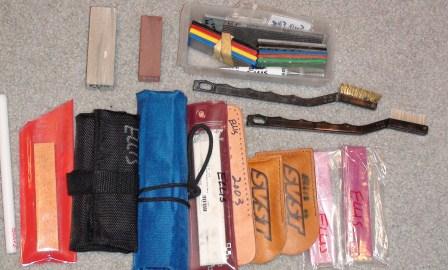Tuning with stones is both the low-end entry into ski tuning (stones don't tend to do too much damage) and the top end of edge tuning (cutting/polishing with hand or rotary stones).
But just as my last statement is vague and unclear, the World of Stones is huge, confusing and there are few charts or directions to guide you. Since I already own (at least 1 example of) most all of the Ski Stones currently available, I will try to provide some navigation.
The simple guide (more complex to follow): You should have in your basic tuning kit 1 coarse diamond stone (70 or 100 mm), 1 fine diamond stone (either size), and 1 gummi stone (fine is more useful than coarse). The coarse diamond stone is useful for removing rock damage and for SLIGHT edge sharpening. The fine diamond is great for smoothing the edges after filing, and the gummi is used to remove burrs after sharpening, and for removing light rust.

(Foreground: Moonstones. Background: DMT)
Use Edge Polishing Solution (like SVST's Secret Sauce) when working with the diamonds, but use the gummi dry. Use the solution and a brass brush to keep the diamonds clean. Expect about 1 season of life for a racer skiing 50+ days/year.
The more complex guide: There are SO MANY stones/stone kits available, and at least as many ways to use them. I tune around 200 pairs/year and I am always experimenting... but I am also continually looking to simplify and standardize my process. The more consistent the tune, the more consistently the skis will perform. With consistent skis, a skier can improve more quickly. With a poor tune, a skier (racer) will have to compensate for the tune, and this can keep them from skiing their best. Here is some of what I have learned:
There are 5 main families of stones: Arkansas, Ceramic, Diamond, Gummi and Rotary.

(Foreground: Arkansas and Gummi, Background: Ceramic, also tuning stick)
Arkansas Stones: These are natural stones, they are quite hard, quite smooth, and are used mostly as a very late-stage edge treatment to both smooth the edge and to condition (harden) it. These are useful on speed skis when chasing the last .001 second, and for the ultimate ski feel. The subtlety of the improvement provided by this treatment, along with the amount of time required to do it, means you should reserve such use for championship speed events... and/or long, lonely nights in the shop- preferably with good tunes. Grits range from 600-1500+ They will break if you drop them. Use them wet (water or solution), and clean them with Wax Remover.
Ceramic Stones/kits: These are formed stones using aluminum oxide and/or other abrasives. Each brand works a little differently, each has a little different "feel" to it. If you want to use ceramic stones, buy a kit from one supplier (SVST and Ski Visions are both excellent) and use them in a progression. Use wet, and clean with wax remover. Grits range from 150-750. ***Note*** THESE STONE WEAR and MUST be maintained to be useful. Every other tune, the stone must be "dressed" using a large diamond stone in running water. If you don't dress them (or replace them) often, they will develop ruts on the surface and mess up your edge geometry. Ceramic stones can be a bit expensive to use. If not re-dressed, they may only last 1-3 tunes- especially the coarser stones.

(Stones and files are fragile and expensive. individually wrap for travel)
Diamond Stones/kits: These are aluminum or plastic "stones" with industrial diamonds (diamond dust) attached with glue. These are the most versatile, useful, and easiest to use stones. There are several brands available, I use mostly DMT and Moonstones. Some say the more expensive stones last longer/work better... but I can't seem to prove that no matter how hard I try. In my experience, one lasts about as long as the other. I like the cheap ones because I can afford to replace them more frequently. Use these wet, clean with polishing solution and a brush OR with wax remover and a paper towel. Always dry your stones before putting them away. Grits available range from 80-1500. Expect to consume 1-2 stones of each grade you use frequently every season.
Diamond/Ceramic comparison: ceramic stones are "smoother," even if the rated grits are the same. Ceramic stones provide the best edge finish. Diamond stones are easier to use, more versatile, and cheaper over time. Diamond stones are less likely to get damaged by abuse also.
Gummi Stones: The fine gummis are useful as the final edge finishing stage to polish away the final bit of burr that remains after tuning. The coarse stones work great to remove light rust before edge work begins.
Rotary Stones: These are the newest development in the home-tuner's kit, and for most people, they are not a good investment. Even the top rotary stone (used in shops and by top techs) cannot finish the edge with the same smoothness of a hand stone. On injected ice however, the additional burr created by the rotary stone is an advantage as it grips better. The rough edge created by a rotary stone does not glide as fast as a hand-polished edge, especially on softer snow. The cost of these fancy tools range from $250 to $3500.
Look for my YouTube videos to show you how to use all these stones.